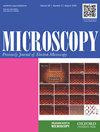软x射线发射光谱仪获得的铁l发射光谱的自吸收结构分析技术
IF 1.9
4区 工程技术
Q3 MICROSCOPY
引用次数: 0
摘要
摘要优化了从不同加速电压下获得的Lα、β发射光谱导出L自吸收光谱的方法,用于分析固体材料中Fe的化学状态。使用伪Voigt函数拟合所获得的Fe Lα,β发射光谱,并通过每条Fe Ll线的积分强度进行归一化,该积分强度不受L2,3吸收边缘的影响。自吸收光谱是通过将在低加速电压下收集的归一化强度分布除以在较高加速电压下采集的归一化强度谱来计算的。所获得的轮廓被称为软X射线自吸收结构(SX-SAS)。将该方法应用于六种铁基材料(Fe金属、FeO、Fe3O4、Fe2O3、FeS和FeS2),观察这些材料中Fe的不同化学状态。通过比较铁氧化物的自吸收光谱,可以观察到L3吸收峰结构显示出随着铁(3+)Fe相对于铁(+2)Fe的增加而向较高能量侧移动。金属Fe和FeS2的自吸收光谱的强度分布显示出L3和L2吸收峰之间的肩部结构,这在Fe氧化物的光谱中没有观察到。这些结果表明,SX-SAS技术可用于检测X射线吸收结构,作为了解过渡金属元素化学状态的一种手段。本文章由计算机程序翻译,如有差异,请以英文原文为准。
Analytical technique for self-absorption structure of iron L-emission spectra obtained by soft X-ray emission spectrometer
Abstract The method deriving the L self-absorption spectrum from Lα,β emission spectra obtained at different accelerating voltages has been optimized for analyzing the chemical state of Fe in solid materials. Fe Lα,β emission spectra obtained are fitted using Pseudo-Voigt functions and normalized by the integrated intensity of each Fe Ll line, which is not affected by L2,3 absorption edge. The self-absorption spectrum is calculated by dividing the normalized intensity profile collected at low accelerating voltage by that collected at a higher accelerating voltage. The obtained profile is referred to as soft X-ray self-absorption structure (SX-SAS). This method is applied to six Fe-based materials (Fe metal, FeO, Fe3O4, Fe2O3, FeS and FeS2) to observe different chemical states of Fe in those materials. By comparing the self-absorption spectra of iron oxides, one can observe the L3 absorption peak structure shows a shift to the higher energy side as ferric (3+) Fe increases with respect to ferrous (+2) Fe. The intensity profiles of self-absorption spectra of metallic Fe and FeS2 shows shoulder structures between the L3 and L2 absorption peaks, which were not observed in spectra of Fe oxides. These results indicate that the SX-SAS technique is useful to examine X-ray absorption structure as a means to understand the chemical states of transition metal elements.
求助全文
通过发布文献求助,成功后即可免费获取论文全文。
去求助
来源期刊

Microscopy
Physics and Astronomy-Instrumentation
CiteScore
3.30
自引率
11.10%
发文量
76
期刊介绍:
Microscopy, previously Journal of Electron Microscopy, promotes research combined with any type of microscopy techniques, applied in life and material sciences. Microscopy is the official journal of the Japanese Society of Microscopy.
 求助内容:
求助内容: 应助结果提醒方式:
应助结果提醒方式:


